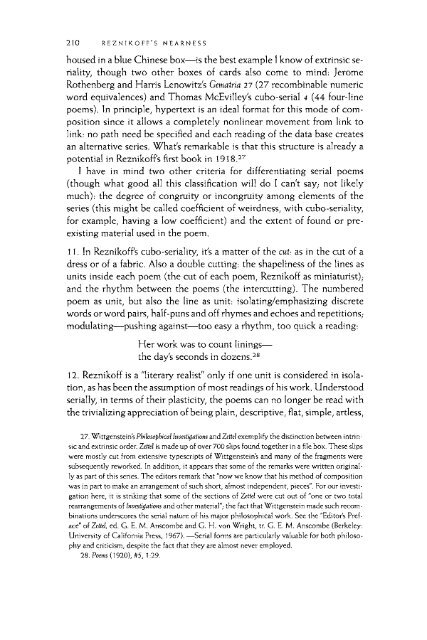My Way_ Speeches and Poems - Charles Bernstein
My Way_ Speeches and Poems - Charles Bernstein
My Way_ Speeches and Poems - Charles Bernstein
You also want an ePaper? Increase the reach of your titles
YUMPU automatically turns print PDFs into web optimized ePapers that Google loves.
210 REZNIKOFF'S NEARNESS<br />
housed in a blue Chinese box-is the best example I know of extrinsic seriality,<br />
though two other boxes of cards also come to mind: Jerome<br />
Rothenberg <strong>and</strong> Harris Lenowitz's Gematria 27 (27 recombinable numeric<br />
word equivalences) <strong>and</strong> Thomas McEvilley's cubo-serial 4 (44 four-line<br />
poems). In principle, hypertext is an ideal format for this mode of composition<br />
since it allows a completely nonlinear movement from link to<br />
link: no path need be specified <strong>and</strong> each reading of the data base creates<br />
an alternative series. What's remarkable is that this structure is already a<br />
potential in Reznikoff's first book in 1918.27<br />
I have in mind two other criteria for differentiating serial poems<br />
(though what good all this classification will do I can't say; not likely<br />
much): the degree of congruity or incongruity among elements of the<br />
series (this might be called coefficient of weirdness, with cubo-seriality,<br />
for example, having a low coefficient) <strong>and</strong> the extent of found or preexisting<br />
material used in the poem.<br />
t t. In Reznikoff's cubo-seriality, it's a matter of the cut: as in the cut of a<br />
dress or of a fabric. Also a double cutting: the shapeliness of the lines as<br />
units inside each poem (the cut of each poem, Reznikoff as miniaturist);<br />
<strong>and</strong> the rhythm between the poems (the intercutting). The numbered<br />
poem as unit, but also the line as unit: isolating/emphasizing discrete<br />
words or word pairs, half-puns <strong>and</strong> off rhymes <strong>and</strong> echoes <strong>and</strong> repetitions;<br />
modulating-pushing against-too easy a rhythm, too quick a reading:<br />
Her work was to count liningsthe<br />
day's seconds in dozens.28<br />
t 2. Reznikoff is a "literary realist" only if one unit is considered in isolation,<br />
as has been the assumption of most readings of his work. Understood<br />
serially, in terms of their plasticity, the poems can no longer be read with<br />
the trivializing appreciation of being plain, descriptive, flat, simple, artless,<br />
27. Wittgenstein's Philosophical Investigations <strong>and</strong> Zettel exemplify the distinction between intrinsic<br />
<strong>and</strong> extrinsic order. Zettel is made up of over 700 slips found together in a file box. These slips<br />
were mostly cut from extensive typescripts of Wittgenstein's <strong>and</strong> many of the fragments were<br />
subsequently reworked. In addition, it appears that some of the remarks were written originallyas<br />
part of this series. The editors remark that "now we know that his method of composition<br />
was in part to make an arrangement of such short, almost independent, pieces". For our investigation<br />
here, it is striking that some of the sections of Zettel were cut out of "one or two total<br />
rearrangements of Investigations <strong>and</strong> other material"; the fact that Wittgenstein made such recombinations<br />
underscores the serial nature of his major philosophical work. See the "Editor's Preface"<br />
of Zettel, ed. G. E. M. Anscombe <strong>and</strong> G. H. von Wright, tr. G. E. M. Anscombe (Berkeley:<br />
University of California Press, 1967). -Serial forms are particularly valuable for both philosophy<br />
<strong>and</strong> criticism, despite the fact that they are almost never employed.<br />
28. <strong>Poems</strong> (1920), #5,1:29.


